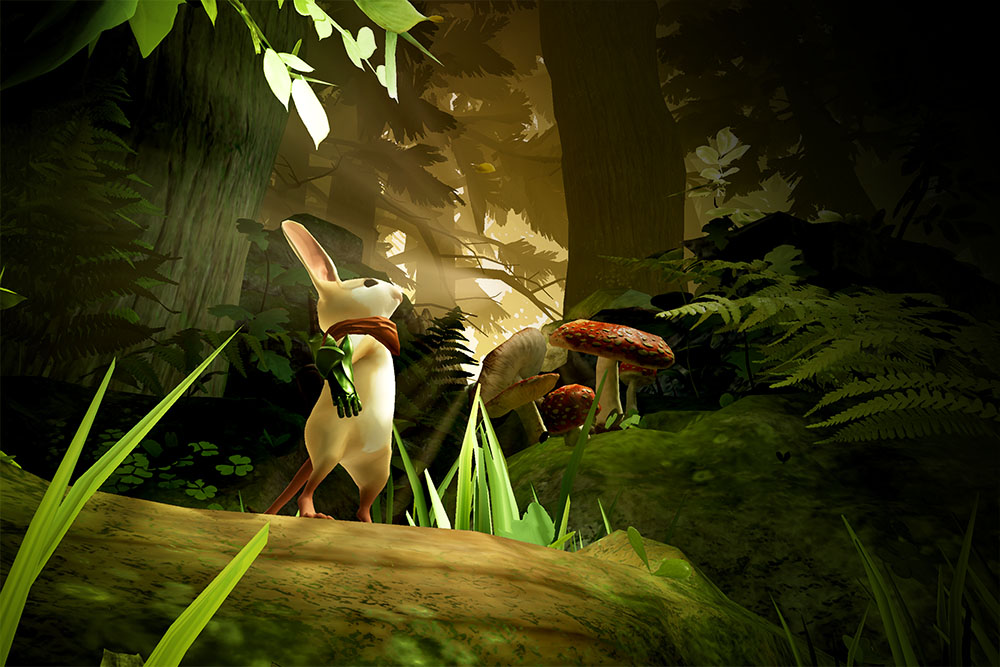Developers continue to get on board with PlayStation VR, which was fully illustrated at this year’s E3, where the company announced that it was partnering with CCP to make its headset the launch platform for the upcoming virtual sport Sparq. A montage of VR game announcements was shown at the PlayStation pre-E3 presentation amid gameplay demonstrations for core franchises such as God of War and Horizon: Zero Dawn, and attendees were able to go hands-on with PSVR games on the show floor.
One game that stood out in the VR game montage was Moss, an action puzzle adventure game currently in development by Polyarc. The debut showing was unique because it wasn’t a high-action shooter. Instead, players—who take the role of a spirit-like figure called “The Reader”—are invited to step into a storybook world to help a cute little anthropomorphic mouse named Quill as she embarks on an adventure to save a loved one. Players help Quill on her quest by manipulating objects in the world to solve 3D puzzles.

Speaking with AlistDaily, Tam Armstrong, CEO, studio director and co-founder of Polyarc, said that Moss came from determining VR’s strengths and building a game around it.
“The thing that everybody talks about first is the sense of presence and realism being in a [VR] location,” said Armstrong. “So, we knew we wanted to make a game that took you to fantastical places. The second thing we wanted to leverage was interaction. We wanted to make sure you were physically interacting with the game, and that’s where the puzzle part came from. We imagined how much fun it would be to move pieces around and manipulate the environment.”
Polyarc has had an ongoing relationship with Sony, according to Armstrong, who said that the company was very impressed with early prototypes of the game. Sony has been supportive of the game ever since, which culminated into bringing Polyarc to E3 and having the debut trailer shown at the PlayStation presentation.
Armstrong stated that the partnership was the main reason why Polyarc chose to launch Moss for the PSVR first, in addition to how the technology fit nicely with the gameplay. He also looks forward to working further with Sony to promote Moss as they approach the game’s launch this winter.
Fans appeared to have taken very well to Moss and its tiny protagonist.
“We’re very excited with the response,” said Armstrong. “We think it’s a cool game, but you’re always nervous when you’re showing something to a wider audience for the first time, and it was nice to see people responding so well. It was also nice to see people picking up on some of the thematic things we were hoping they’d appreciate, like your relationship with Quill and your role in helping her succeed. It was cool to see people gravitate towards that.”
Being a spirit-like character in a storybook VR game might be a lot to take in, but Armstrong sees spreading awareness however possible as a big win for the game, technology and industry.
“We try not to overly focus on all of those elements,” Armstrong explained. “If someone saw or played our game and all they took away was that it was Quill’s adventure in trying to rescue her loved one, then we would be absolutely thrilled. We would be fine with that, but we’re sure there will be players who will appreciate the depth and we want something for everybody.
“As far as marketing goes, the biggest challenge is with VR in general. It’s hard to display that medium in the same way that it’s hard to sell a TV on radio. It’s not impossible, it’s just hard until everyone can visualize a TV in their heads. We have the same challenge now with VR—it’s hard to sell the experience of being in VR through watching a video. The more players become familiar with what VR feels like, the more they’ll be able to project themselves into what they’re seeing. That’s really hard to do right now, so we’re focusing on very apparent things by showing people the richness of our world and characters. Hopefully, they’ll find those things intriguing enough to find out more.”
Having an adorable mouse as the main character probably helps quite a bit in having a game be accepted.
“We came up with Quill as a matter of scale,” said Armstrong. “We knew that we wanted a puzzle game where you interacted with the environment, and that meant that we were either going to make the player a giant to reach a meaningful amount of the space, or make a tiny hero to make the player feel big. We shied away from making the player large because we didn’t think that would feel very realistic. Your brain reminds you that you’re not actually a giant. So, we made a tiny hero and scaled the world to suspend disbelief.
“The matter of theming came from discussing ways to make a tiny hero—[we had] toys, aliens or little animals—and we settled on the mouse protagonist. As far as Quill’s cuteness goes, we would like people to perceive her as self-sufficient, strong and confident, although she does need your help on a journey. If audiences pull out the fact that she’s cute, we have no objection to that. More than anything else, having a tiny being that you have a relationship with and you believe is alive is very powerful in VR because your head and hands are in the experience. There’s a more direct connection with those characters than there would be through a TV screen. If the side effect of that is that it gets people interested in our game, then that’s great. Our goal is to capitalize on VR’s strengths.”
Games like Moss are critical to the success of VR, and Armstrong believes that it will take some time for VR to be adopted as more software comes out.
“None of us buy a console or platform without having a few games we want to play, and all of that takes time. We’re not worried right now because this is the expected outcome, and we want to use our experience to help bring new software to the VR platform. Hopefully, we’ll be on the list of reasons why people get excited about VR and want to buy it.”
Exploring experiences that aren’t possible through traditional means is the whole reason Polyarc decided to create Moss. Armstrong said, “Moss isn’t Moss unless you can reach in and grab things and move them around. It’s not Moss unless Quill can look you in the eyes. This is our chance to go after something new and exciting to establish ourselves.”
That being the case, he isn’t put off by the limited install base. “Polyarc’s mark of success is an appreciation from our players, irrespective of scale. In terms of the limited install base, that’s just the business problem of not spending too much money making a game so you have a chance to make more. Independent of that, we just want people to appreciate it. To me, it doesn’t matter if there are 10 million or 1 million customers. Just knowing that a portion of those customers are really excited about what you’re doing—that’s the creative mark of success.”
Success for both the game and VR lies in getting them in the hands of players. “The key is being hands-on,” said Armstrong. “You have to get people to play and try it because it’s very difficult for people to imagine if a VR game is fun or not from a description, and that’s true for everyone. So, experiencing games is the key.”
To this end, Polyarc will be taking the game to shows and is engaging with audiences both in-person and through social media to spread the word about Moss.
“Promotion will rely a lot on word-of-mouth, like in the early-console days before there were a lot of advertisements,” said Armstrong “There needs to be people trying VR then talking to their friends about it.”

